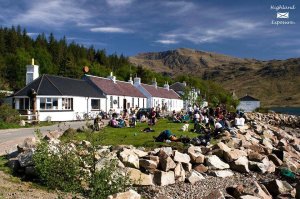Archiviato in: Knoydart, proprietà fondiaria, ferrovie, realtà, sostenibilità — derryvickers @ 11:46 am modifica questo
Abbiamo trascorso tre giorni a Knoydart soggiornando nella Bunkhouse della Knoydart Foundation a Inverie. Inverie è il villaggio principale, anzi l’unico villaggio.

The Village
Il villaggio
Ci sono alcune case sparse in tutta la peninsulare.
Abbiamo fatto due buone passeggiate da Inverie, a Doune dove c’è un buon ristorante vicino alla riva (anche se a 200 metri in discesa ci siamo astenuti dal campionamento) e alla cascata su una bruciatura sotto Ladhar Beinn (un Munro), ciascuno circa 20 km.

The Waterfall
La cascata
Vedi mappa semplice

A Simple Map of Knoydart
Una semplice mappa di Knoydart
Un piccolo background: Knoydart fu uno dei primi acquisti della Comunità dal proprietario terriero della penisola di Knoydart. La metà è ora di proprietà della Comunità, mentre l’altra metà è di proprietà del John Muir Trust. Knoydart non è un’isola, anche se in realtà è come non vi è alcun collegamento stradale alla comunità. Si può raggiungere a piedi da Loch Hourn, ma ci vogliono due giorni oltre brughiera. Si può anche camminare da Glenfinnan ma al momento c’è un ponte vitale sostituito.
Cito “la Fondazione Knoydart è stata istituita nel 1997 per lavorare per conto della Comunità nel prendere la proprietà della zona di terra coperta da Knoydart estate in quel momento. La penisola di Knoydart, che non è collegata alla rete stradale continentale, fa parte di un’ area panoramica nazionale (Clicca per scaricare il foglio informativo). ”
Per un po’ più di dettaglio vedere https://en.wikipedia.org/wiki/Knoydart con un sacco di foto.
Ma l’essenza di Knoydart è la sua comunità che ha costruito fino a circa 100 persone. Knoydart fu efficacemente cancellato durante le Highland Clearances. Le persone naturalmente lasciano, ma più arrivano. C’è ora una scuola primaria attiva, mentre i bambini delle scuole secondarie sono boarder settimanali a Mallaig.

Mallaig – a busy port
Mallaig – un porto occupato
la città più vicina con un collegamento stradale continentale. _ la Comunità deve essere autoportante e c’è il negozio del villaggio, il caffè gestito da due eccellenti sorelle da forno, l’ufficio della Fondazione e il local pub che afferma di essere il più lontano ovest sulla terraferma di qualsiasi pub in nel Regno Unito. L’elettricità è alimentata da un sistema idroelettrico degnato e costruito a livello locale, fornito da un vicino lago e TV e Internet da un ricevitore/trasmettitore, alto sopra il villaggio; anche, casa progettato e costruito. Lo schema è comune collegamento in Mallaig e South Skye pure.
Un’attività principale è la registrazione per l’esportazione

The Timber Yard
Il cantiere del legname
; case sono sorprendentemente costruite in legno e ci sono alcune belle nuove nel villaggio. La terra viene reimpiantata per il futuro, anche se le piantature semplici abbondano ancora.

The Waterfall
Un boschetto di betulla incontaminata sulla strada per la cascata
. Mentre lo stalking del cervo può essere considerato uno sport dei ricchi, su Knoydart è una necessità come i cervi devono essere abbattuta per controllare il loro numero; nuova scherma abbonda. La Fondazione sta per iniziare a raddoppiare le dimensioni della sala del villaggio; è il centro della Comunità, ma ha bisogno di espandersi per fornire una casa per tutto ciò che va avanti. Un nostro amico è Davie Newton che intraprende e dirige la gestione operativa. C’è sempre molto da fare e mentre eravamo lì, c’era un gruppo di volontari ‘ jolly ‘ dal John Muir Trust rifacendo i fossati; l’acqua piovana è sempre un problema.

The John Muir Team of Volunteers
Il team di volontari di John Muir
Anche se non c’è alcun collegamento stradale al mondo esterno Knoydart ha la propria rete stradale e auto e 4by4s sono traghettato e molto apprezzato! Il traghetto è naturalmente un collegamento essenziale per le persone e il cibo e per sottoscrivere come c’è fiducia nella Comunità la compagnia di traghetti, Western Isles Cruises, ha recentemente acquisito una nuova barca veloce che si strati tra Mallaig e Inverie e il tempo di attraversamento è ridotto da tre quarti di un’ora a meno di mezz’ora con la più antica barca tradizionale (che è ancora in servizio).

The big boat with Rhum in the distance
La grande barca con rhum in lontananza
Una caratteristica fondamentale dello sviluppo è la gestione della terra e c’è un Ranger dedicato e molto attivo, Amie, che gestisce la terra e si concentra sulla “sostenibilità” in particolare piantando nuovi alberi. Sottolinea che le foreste più vecchie non possono essere facilmente raccolte perché sono state piantate con l’estrazione di cavalli e non ci sono più cavalli su Knoydart; un cambiamento non facilmente reversibile dove i trattori ora dominano. Amie organizza viaggi organizzati intorno alla sua Land Rover; La Land Rover Defender è la dominante 4 per 4 non sorprende e non sono chiaro che cosa accadrà a pezzi di ricambio ora la Land Rover non li stanno facendo più. Naturalmente, i turisti sono una fonte di ricchezza e Inverie è un centro per escursionisti appassionati che arrivano in barca o in da Loch Hourn e Glenfinnan.
Per inciso, per i tifosi di Stuart Glenfinnan è dove Bonny Prince Charlie alzò il suo standard nel 1745. Più recentemente per i fan di Harry Potter, il ruscello Jacobite scorre tra Fort William e Mallaig via Glenfinnan sul viadotto di cemento Bob. Il treno e gli allenatori erano a Mallaig stazione quando siamo arrivati

The Jacobite waiting to depart from Mallaig
Il Jacobite in attesa di partire da Mallaig
A mio modo di vedere, la comunità di Knoydart deve essere lodata; hanno acquistato e istituito la Fondazione e nel corso dei pochi anni siamo stati andando a Knoydart la Comunità sta crescendo in forza e resilienza e forse, soprattutto, la vita sta assumendo una “normalità”. Apprezzo che la vita in estate sembra facile (a parte i moscerini)

Sunset looking towards Rhum
Tramonto guardando verso rhum
ma poi ci sono i lunghi inverni bui, anche se alcuni della comunità ci hanno detto che questi sono giorni migliori in quanto possono rilassarsi e fare ciò che non possono in estate. La Scozia ha bisogno di tali comunità, sostituzioni per i villaggi rimossi dai Clearances, ed è bello vedere Knoydart fiorente e il New Village Hall è un segno per il futuro positivo.














